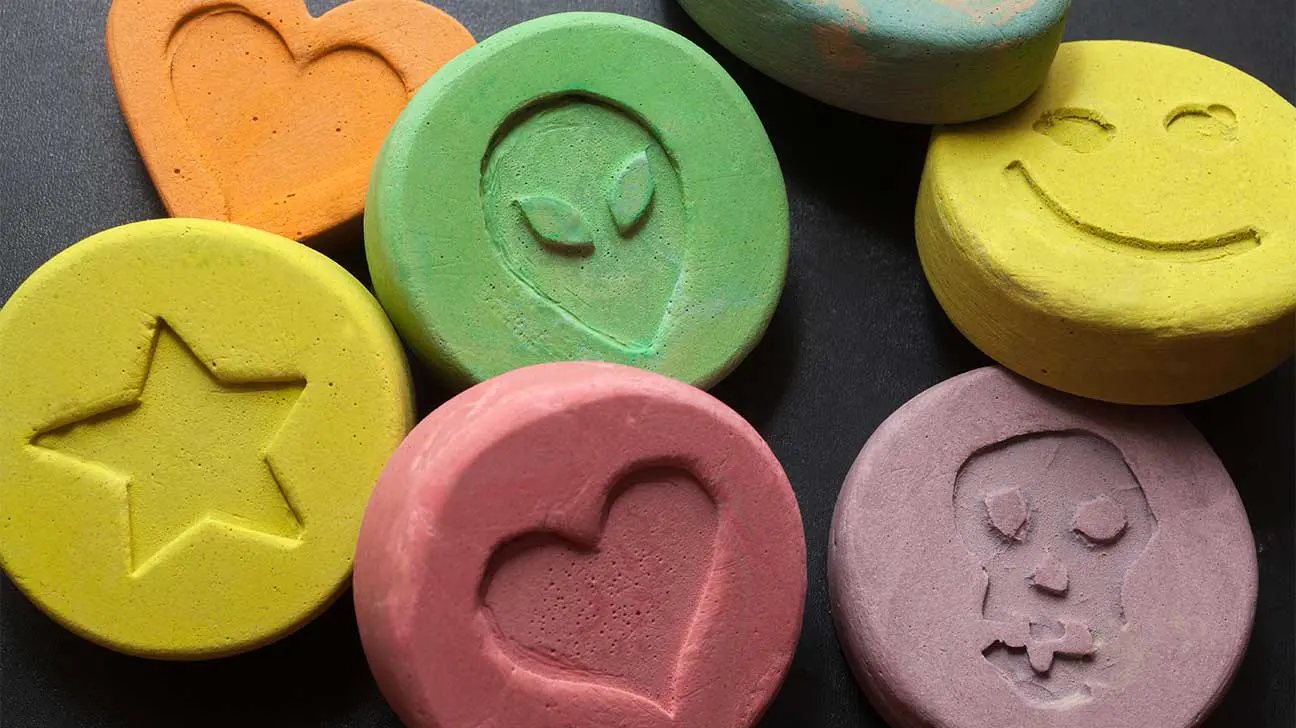
Hallucinogens are a class of drugs that change the way people perceive the world around them.
These drugs are considered dangerous because people can harm themselves or others while detached from reality.
Categories Of Hallucinogens
The two main types of hallucinogens are classic hallucinogens and dissociative hallucinogens. The main difference is the effect they have on emotions.
Dissociative hallucinogens cause feelings of detachment and depersonalization that classic hallucinogenic drugs don’t cause. Consult our list below to better understand these two categories.
List Of Classic Hallucinogens
Classic hallucinogenic drugs existed long before the creation of the newer types of dissociative drugs that are available today.
These drugs are known for their hallucinatory effects, which changes the person’s perception of reality. It is common for auditory and visual hallucinations to occur the very first time hallucinogens are taken.
Methods of abuse can include inhaling, swallowing, smoking, snorting, or injecting.
The four most common classic hallucinogens are:
- LSD
- Psilocybin
- Peyote
- DMT
LSD
Lysergic acid diethylamide (LSD) is made from a fungus that grows on rye plants. The drug is commonly referred to as “acid” when it is sold or purchased on the streets.
Drug dealers often place just a single drop of it on individual sugar cubes for those who buy it. Sometimes, it is also put on stickers or pieces of absorbent paper called “blotters” so that it can be licked off or chewed.
LSD is dangerous because it has no odor or smell. Small children who don’t realize what it is can easily be harmed if they come in contact with it.
Effects of LSD
Some people claim that this drug will boost their cognitive function if they take a small amount of it on a regular basis.
There has been no medical research done that can prove that LSD is able to do anything more than induce paranoia, hallucinations, dry mouth, sweating, and psychosis.
In fact, some doctors believe that it may be responsible for permanent brain damage in some people.
Psilocybin
The chemical name for psilocybin is PY, 4-phosphoryloxy-N, N-dimethyltryptamine.
Since psilocybin comes from special mushrooms that grow in warm, tropical regions of the world, such as Mexico and South America, the street names for psilocybin include “shrooms” or “magic mushrooms.”
Origin And Effects Of Psilocybin
Psilocybin was used as a ceremonial drug by Indigenous people who lived in Mexico and certain countries in Central and South America where the the mushrooms originated.
The Aztecs, for example, called it teonanacati which means “god’s flesh.” They believed that it will help them become connected to spirits and see visions of the past and future.
When it is used for this purpose, the mushrooms are often steeped in hot water to make a tea to drink, but the mushrooms may also be consumed raw or dried.
Psilocybin can cause psychosis, vomiting, coma, and, in rare cases, death from an overdose.
Peyote
Peyote is a type of cactus that grows in the southernmost region of the United States and some parts of Mexico. It has a very unpleasant taste when it is eaten raw.
As a result, the top portion of the plant is often boiled for a considerable amount of time so that a tea can be made from it instead.
Some chemically synthesized versions of peyote are available too. Besides hallucinations, peyote can cause terrors, panic, intense fear, and an inability to sense time correctly.
It seems to have this effect because of its impact on the neurochemical called “serotonin.”
DMT
Dimethyltryptamine (DMT) is a chemical found in a tea called “Ayahuasca” that is made from a combination of vines and other plants that grow only in the rain forests of the Amazon.
Since most people of the world don’t have access to the plants, they often just purchase the chemical version of DMT that is made in laboratories instead.
The effects of DMT include intense auditory and visual hallucinations, an altered sense of time, and depersonalization.
Physical effects can include:
- agitation
- high blood pressure
- dizziness
- dilated pupils
- increased heart rate
- seizures.
List Of Dissociative Hallucinogens
Dissociative hallucinogens have many of the same properties of classic hallucinogens, but also cause a person to dissociate, or lose touch with reality, while abusing the drugs.
The two main hallucinogenic drugs that have dissociative properties are:
- PCP
- Ketamine
PCP
Phencyclidine (PCP) was invented by doctors several decades ago for the purpose of blocking out pain and keeping patients unconscious during surgery.
Now, it is consumed in many different ways by those who abuse it, such as swallowing, snorting, injecting, and smoking it.
It may be smoked on its own in a glass pipe that is heated up, but it is more common for people to simply add a sprinkle of it to a rolled-up cigarette that is easier to conceal.
Effects of PCP
Sometimes, PCP is mixed with other illegal drugs or hallucinogens such as ketamine. This can indicate a polysubstance use disorder.
This is especially dangerous because an overdose on this combination can cause someone to stop breathing. They may also develop seizures and convulsions or go into a coma.
Ketamine
Ketamine commonly goes by the street name “Special K.” The drug has no odor or color. It can cause hallucinations and temporarily wipe out a person’s memory.
Ketamine comes mainly from veterinary offices because it works as an effective animal anesthetic, but it can be used as an anesthetic for humans and as a treatment for depression.
Ketamine is also one of three drugs commonly referred to as date-rape drugs. People who are planning a sexual assault often add it to a victim’s drink when they aren’t looking.
Because of this, law enforcement officials often warn people to never let their drink leave their sight when they go to a party or club.
List Of Hallucinogens By Drug Schedule
The U.S. Drug Enforcement Administration (DEA) classifies all drugs (legal and illegal) into drug schedules, which are determined based on a drug’s medical value and potential for abuse.
For example, Schedule I drugs have no medical value and are highly addictive. The drugs in Schedules II-V have medical value but are listed in terms of abuse potential, which decreases as you go down the Schedules.
The following is a list of hallucinogenic drugs by DEA drug schedules.
Schedule I Hallucinogenic Drugs
Schedule I hallucinogenic drugs are not prescribed by doctors because they have no medical purpose.
They also get this rating because of the way they are commonly abused and the mental and/or physical damage that they cause the body. Most hallucinogenic drugs are listed in Schedule I.
Drugs with hallucinogenic properties that are listed as Schedule I include:
- Salvia divinorum
- Ibogaine
- N-bomb
- GHB
- DMT
- Psilocybin
- Ecstasy
- LSD
- Peyote
- bath salts
- Marijuana
- Methamphetamine (included because of the hallucinations that it causes)
Schedule II Hallucinogenic Drugs
Schedule II hallucinogenic drugs can be prescribed by doctors because they have some medical purposes.
However, there is a high risk of them being abused or causing addiction or physical dependency because of the effects they have on the body.
Two of the main hallucinogenic drugs that are listed as Schedule II include:
- Nabilone
- PCP
Schedule III Hallucinogenic Drugs
Schedule III hallucinogenic drugs are considered to be less dangerous because they have a lower risk of addiction, dependency, and damage to the mind and body.
The two hallucinogenic drugs that the DEA includes on the Schedule III list are:
- Ketamine
- Dronabinol
Find Treatment For Drug Abuse Today
Are you or a loved one battling substance abuse and looking for a drug rehab center for treatment? Call us today to learn more about your treatment options and how to start the recovery process.
Addiction Resource aims to provide only the most current, accurate information in regards to addiction and addiction treatment, which means we only reference the most credible sources available.
These include peer-reviewed journals, government entities and academic institutions, and leaders in addiction healthcare and advocacy. Learn more about how we safeguard our content by viewing our editorial policy.
- National Institute on Drug Abuse — Common Hallucinogens and Dissociative Drugs
https://www.drugabuse.gov/publications/research-reports/hallucinogens-dissociative-drugs/what-are-dissociative-drugs - U.S. Drug Enforcement Agency — Hallucinogen
https://www.dea.gov/taxonomy/term/321 - U.S. Drug Enforcement Agency — Controlled Substance Schedules
https://www.deadiversion.usdoj.gov/schedules/


